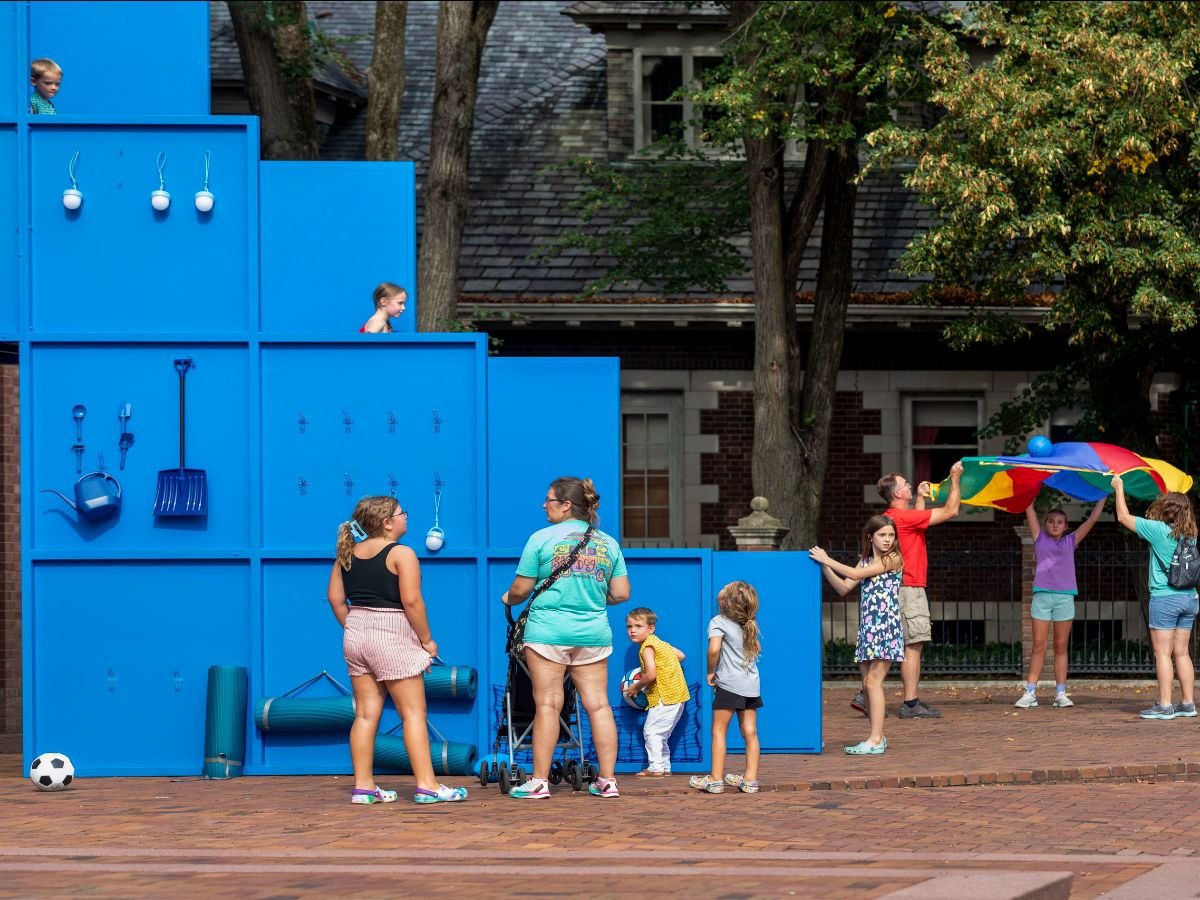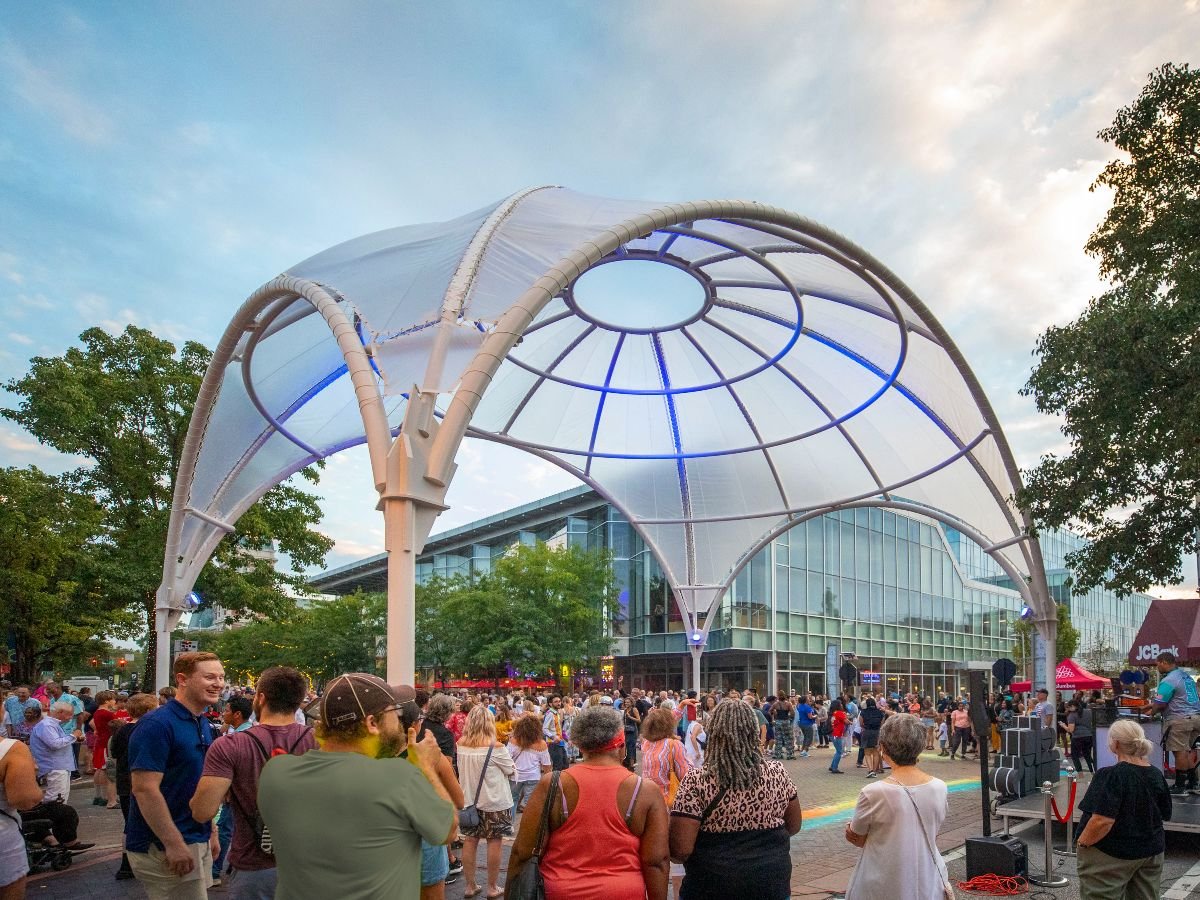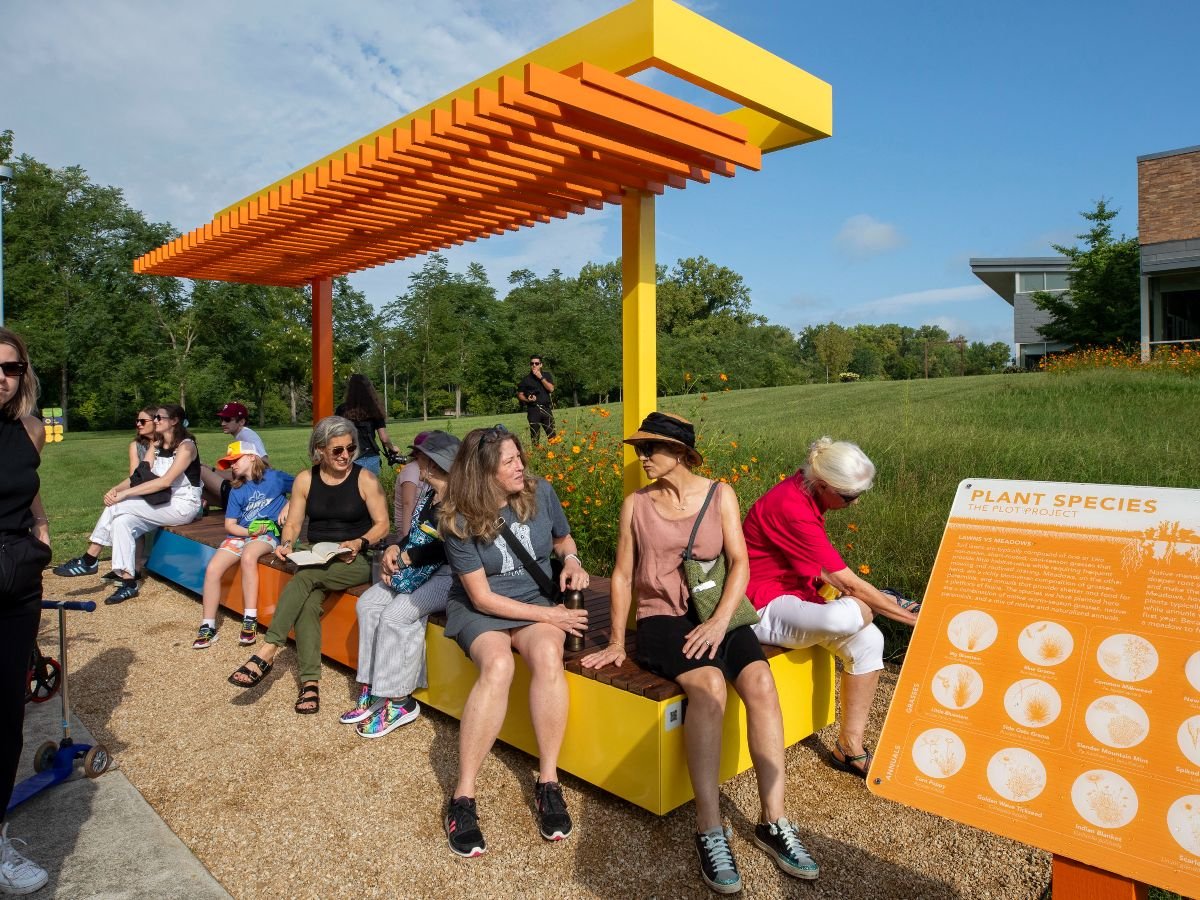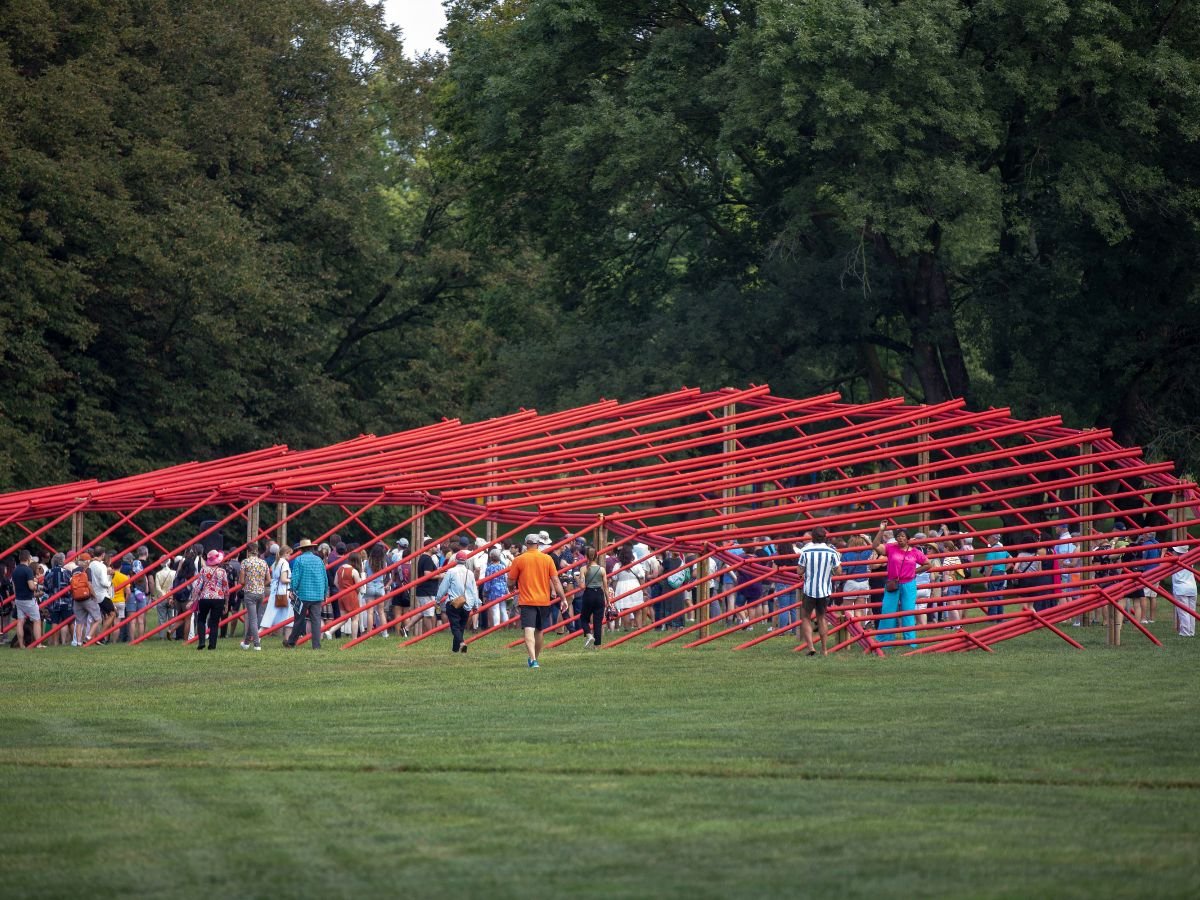Exhibit Columbus 2023, Public By Design, Opens
On Saturday, thousands of community members and visitors joined the participants, curators, and Landmark Columbus Foundation Staff to experience 13 new works of art and architecture and to celebrate in one of America’s most renowned design meccas.
Exhibit Columbus is the only program of its kind that engages in an international dialogue connected to the biennial exhibition structure while addressing the challenges that cities around the globe are facing today.
The Exhibition is proclaimed a “public tour de force” by The Republic newspaper. Open through November 26, 2023.
Top left: Tatiana Bilbao ESTUDIO, Public by design; Top right: PAU, InterOculus
Bottom left: PORT, THE PLOT PROJECT; Bottom right: Studio Zewde, Echoes of the Hill
Columbus, Indiana — This past Saturday, thousands of community members and visitors came to downtown Columbus, Indiana to experience the 2023 Exhibit Columbus exhibition, Public by Design, a ground-breaking exhibition that showcases how art and architecture can help build a sense of belonging while revitalizing and reimagining historic downtowns as equitable, beautiful, and joyful places. A Columbus resident said on Facebook of the weekend: “Such a unifying and happy moment. We need more of this stuff in the world.”
“What we’ve built together is very special—an exhibition that residents and visitors want to explore and feel connected with, one that is filled with new places throughout the city where we can create and share meaningful new experiences,” said Mayor James Lienhoop. “I couldn’t be more proud of this community and what this exhibition is all about. This truly is one of the best places in the world to live, and it’s getting better every day.”
The day began with hundreds of people on foot—and dogs on leashes, toddlers in strollers, and kids on scooters—walking a meandering route around downtown Columbus for an Exhibition Tour to see the 13 newly commissioned installations and hear from their creators: four J. Irwin and Xenia S. Miller Prize Recipients, seven University Design Research Fellows, High School Design Team, Communication Designer, and six Curatorial Partners.
Throughout the day, each installation was activated with free events for visitors of all ages, including musical performances, games such as bocce, and children’s storytime. In the afternoon, the curators shared their vision and process for Public by Design in a Curatorial Conversation inside the iconic sanctuary of First Christian Church, where they discussed how Exhibit Columbus is different from every other architecture and design exhibition. “We wanted to demonstrate the basic idea that the best work is built with a broad belief in the collective power of community work and engagement,” said Bryony Roberts, one of the curators and Miller Prize Recipient in the 2018–2019 cycle of Exhibit Columbus.
In the evening, the community gathered downtown for Rock the Block at Practice for Architecture and Urbanism | PAU’s installation, InterOculus, at the intersection of 4th and Washington Streets for dance performances by Dance Street Studio (Swing and Salsa), Monja Ninja (Japanese Dance), Bollywood Beats (Indian Dance), RJ Bhangra Academy (Indian Dance), Dance with Us (Indian Dance), and Black Excellence (African-American Dance) who created a 15-minute show that told the history of the Black experience starting with post-slavery gospel, seventies soul, to today’s hip-hop hits. After the show, the party continued with a free, public dance party. Thanks to state-wide and national support, there was no entrance fee for the exhibition or any of the opening day activities.
“Opening Weekend is the culmination of a lot of work by some of the world’s most talented artists, architects, designers, and our team,” said Richard McCoy, the Founding Executive Director of Landmark Columbus Foundation, which runs the program Exhibit Columbus. “I’ve never felt the kind of community pride and joy on the streets of Columbus, Indiana, that was on display this weekend. This exhibition now stands atop a hill of excellence built on the past three cycles and the hard work of the many participants and staff from the previous three cycles.”
Exhibit Columbus Participants
Awarded to renowned national and international design practices who share J. Irwin and Xenia S. Miller’s commitment to the transformative power of designing with public spaces, four J. Irwin and Xenia S. Miller Prize Recipientsactivated the public spaces of popular downtown Columbus sites.
J. Irwin and Xenia S. Miller Prize Recipients
Tatiana Bilbao ESTUDIO
Mexico City
Installation: Designed by the public
Site: Library Plaza at Bartholomew County Public Library
Community Curator: Jason Hatton
Curatorial Question: How do you connect in public space?
How can we allow for the possibility of public space to become a platform for collective and social exchange, where everyone can perform their own idea of community? That is the question guiding this installation at the iconic Library Plaza. Following this year’s curatorial theme, Tatiana Bilbao ESTUDIO calls for the use of the space to be designed by the public!
Designed by the public encourages visitors to freely use a broad collection of objects, furniture, and equipment to build their own ideas, to allow for all possibilities, and to embrace the unexpected. It literally provides the tools for people to express their desires and intentions, opening up an ongoing participatory process of exchange. The ESTUDIO led design workshops with members of the community through a team effort with the library to bring their social programs outdoors. This is an invitation to everyone to make this public space their own, in their own way.
Practice for Architecture and Urbanism | PAU
New York City
Installation: InterOculus
Site: The Commons
Community Curator: Dave Hayward
Curatorial Question: What is civic identity?
InterOculus is at the crossroads of Indiana’s Columbus, at the intersection of Washington and Fourth Streets. Its canopy form, celebratory purpose, and equitable invitation are derived from an extensive community engagement process. Inspired by influences as diverse as the iconic Pantheon in Rome, local carnival vernacular, ice cream sundaes from Zaharakos, and the wigwams of the Miami and Shawnee peoples, the design creates a visual and physical destination that can help revitalize downtown day and night through the experiences of suspension, illumination, and projection. The project asks the community to enjoy the structure, revel in the city’s historic downtown, and advocate for permanent urban public space that connects Columbus’s diverse communities and mindsets through positive social friction.
PORT
Philadelphia and Chicago
Installation: THE PLOT PROJECT
Site: Mill Race Center
Community Curator: Dan Mustard
Curatorial Question: How does nature connect us?
THE PLOT PROJECT interfaces with the Mill Race Center and its surrounding landscapes to place the Center’s diverse activities and the biodiversity of the park into public dialogue.
By extending and inscribing the arced shape of the Center’s building into the landscape, PORT defines a new arc approximately 1250 feet in length, covering a half-acre of ground. This zone is subdivided into 12 plots that serve as testing beds for landscape rewilding experiments that have been grown over the course of a 9-month growing season. Some plots are left unmown to grow feral, while others are prepped and over-seeded with mixes of native warm-season grasses. Bands of wildflowers, which were seeded with a mix of native and naturalized annuals and perennials, highlight the transition between plots.
Along the outside curve of the rewilded area, survey poles are arrayed at 25 feet intervals, allowing the geometry of the arc to be clearly legible from the ground. At three points along the arc, conservation outreach stations are positioned as new places to reflect that invite social interaction and education. The color of the stations riff on the mid-century formal architectural heritage and color palette of Columbus.
Studio Zewde
Harlem
Installation: Echoes of the Hill
Site: Mill Race Park
Community Curator: Mark Jones
Curatorial Question: What memories are in this landscape?
For the 30th anniversary of Mill Race Park, Studio Zewde explores the deep history of the site—from indigenous landscape technologies to localized histories like the River Rats and the Mill Race Monster. Research was conducted on the community’s favorite stories and spots in this place to identify a strong relationship to landmarks such as the hill, the pond, the trails, and the architectural elements.
This installation engages the interface between one of these beloved landmarks—the hill—and one of these spaces of opportunity—the Festival Field. In the dedication ceremony 30 years ago, the designer of this park, Michael Van Valkenburgh, made explicit reference to the hill’s form echoing the ancient mound-building traditions from the Missippean culture. This installation echoes this hill with red frames and makes the mound’s circle complete, suggesting a new public space for gathering. As a hollow form, the interior of the installation can be activated by special events or everyday usage, while offering a festive backdrop to the open lawn. The installation presents a literal and metaphorical “frame” on the pasts, presents, and futures of this land.
University Design Research Fellows
Awarded to leading professors of architecture, landscape architecture, and design from North American universities, seven University Design Research Fellows were selected to respond to recommendations from the 2021 Downtown Activation Study developed by James Lima Planning and Development (JLP+D) that looked at ways to activate the historic core of downtown Columbus. JLP+D’s work is supported by the City of Columbus and a National Endowment for the Arts “Our Town Grant”.
Joseph Altshuler and Zack Morrison
University of Illinois at Urbana-Champaign School of Architecture
Urbana-Champaign and Chicago, IL
Installation: A Carousel for Columbus
Site: Ovation Plaza
Curatorial Question: Where do you find joy in the city?
A Carousel for Columbus is a locomotive love letter in-the-round. Shapely silhouettes sampled from the city’s iconic architecture huddle together to form a curious carousel, a backdrop for public life in the city. Supergraphics, also sampled from the city’s architecture, animate the walls and ground surfaces of the plaza. The graphics sync into and out of optical alignment with the carousel as it spins in place or as visitors circulate around it.
When programmed as a stage, the rotating platform offers the flexibility for performers to reorient themselves outwards toward a festival crowd along Fourth Street or inwards toward a more intimate audience within the plaza. During un-programmed times, the carousel provides an active platform for physical engagement and visual play. Taken together, the carousel, supergraphics, and performances offer a locomotive landscape that celebrates the power of shape, color, character, and sound to generate a public platform by design.
Esteban Garcia Bravo and Maria Clara Morales
Purdue University Department of Computer Graphics Technology
West Lafayette, IN
Installation: PRISMA
Site: Cummins Parking Garage, West
Curatorial Question: How do we activate space?
PRISMA is an interactive and immersive light installation that invites you to re-activate “invisible” urban spaces with renewed excitement.
Inspired by Columbus’ modern architectural legacy, a rectangular prism is used as a foundation to create an open-air tunnel with a free-flowing, animated lighted experience. Walking through PRISMA, the entire space comes alive with animated lights, each color vibrantly playing off the next. Every color is possible inside PRISMA, and each unique color represents the coexistence of people and communities that share these urban spaces. PRISMA even offers public access to set a particular mood for the prism!
This installation offers a public place to reconnect and celebrate the colorful diversity of life. In collaboration with various community groups, PRISMAserves as an energizing venue to enjoy light performances and pop-up events celebrating music, art and culture, and much more.
Jessica Colangelo and Charles Sharpless
University of Arkansas Fay Jones School of Architecture and Design Fayetteville, AR
Installation: Ground Rules
Site: Cummins Office Building Headquarters
Curatorial Question: Do you play in public space?
Ground Rules floats on an elevated playing court and provides seating under the concrete colonnade of the Cummins Corporate Office Building. The project responds to the monumental building and its location across many streets by inserting an architectural structure within the gridded structure. This installation creates a spontaneous gathering space for office workers and downtown pedestrians alike.
By echoing the existing horizontality of the monolithic beams soaring overhead, Ground Rules establishes its visual presence by striking a new horizontal space hovering just above the ground. In juxtaposition to the weighty permanence of the concrete structure, this new boardwalk is lightweight and temporary in its materiality, primarily constructed from discarded lumber salvaged from construction sites. Additionally, the project is designed in seven-foot-wide modules that are roughly the size of a parking space so that Ground Rules can be disassembled, relocated, and reconfigured after the exhibition to continue the conversation and games in new places.
Deborah Garcia
Massachusetts Institute of Technology Department of Architecture
Cambridge, MA
Installation: RESPONDER
Site: Bartholomew County Public Library
Curatorial Question: What do you hear in public space?
RESPONDER is a sound installation and architectural narrative that focuses on conducting the unique voice of the Cleo Rogers Memorial Library. Responding to the historic idea of modernist buildings and their relationship to their surroundings and the Earth, this work taps into the hidden life of elements that make up a single building and brings forth their presence and their constant variability in space through sound. RESPONDER expands the sonic register of the building beyond its materials and dives into the earth and tectonic shifts that occur below the ground creating a sound amplification of the transformation this building undergoes every day. The installation uses a visual programming language to make this transformation present and immersive through sound and light.
Every evening, programmed to synchronize with sundown, the library will awaken for a 15-minute ‘sigh.’ Its architectural shiftings—the vibration of steel, the soft murmur of brick, the sizzle of electrical wires, and the hum of ventilation—will be transmuted into a therapeutic sound designed to wash over the sunken courtyard of the Children’s Entrance providing a healing sonic pool.
Molly Hunker and Greg Corso
Syracuse University School of Architecture
Syracuse, NY
Installation: Side Effects
Site: The Commons
Curatorial Question: Where do you meet in the city?
Side Effects learns from two qualities of Columbus’ special design legacy—the high-contrast patterns developed by Alexander Girard and the indoor-outdoor continuity deployed by Modernist architectural design—to strengthen the visual and social connection in spaces downtown. This installation also offers a new identity and potential for use at the space on Washington Street.
The project consists of two large, brightly-colored, and patterned shapes that break down the boundary of the interior and exterior. By connecting through the glass, the project aims to create a “continuous” public space that simultaneously serves adjacent indoor programs and outdoor activities. 2D elements of the pattern create a new informal public space while maintaining public right-of-way and accessibility. 3D elements add seating to The Commons main entrance.
Katie MacDonald and Kyle Schumann
University of Virginia School of Architecture
Charlottesville, VA
Installation: Sylvan Scrapple
Site: Columbus Area Visitors Center
Curatorial Question: How do we interpret the past?
Sylvan Scrapple draws parallels between the use of waste in cooking and construction, creating a wooded oasis for dining and exchange.
Non-linear wood unfit for traditional lumber is used to construct curving panels. Boards cut on a purpose-built robotic sawmill are stacked into snaking walls, making use of natural curvature to create thin structural surfaces.
Bricks salvaged from the burned Irwin Block and renovated First Christian Church tower are collected in metal gabion cages. Gabions double as pieces of urban furniture, such as walls, dining table, coffee table, and stairs.
Wood, bricks, and scraps form a 15’ dining table that creates a center for the installation. Bound with bioresin, this table closely resembles congealed scrapple. A game of “I spy” uncovers panels salvaged from Eliel Saarinen’s church tower and branches from Mill Race Park. This table is the venue for Table Scraps, an exhibition combining recipes with place settings, all sourced from the public.
Halina Steiner, Tameka Baba, Forbes Lipschitz, Shelby Doyle
The Ohio State University Austin E. Knowlton School of Architecture and Iowa State University School of Design
Columbus, OH and Ames, IA
Installation: PIPE UP!
Site: Hotel Indigo
Curatorial Question: Where does your water go?
PIPE UP! makes visible the subterranean water infrastructure of urban development and agricultural production, telling a visual, kinesthetic story about altered hydrologies. A vast network of buried pipes moves water throughout the built environment. They can also transport excess nutrients, dissolved pollutants, and sediment-bound toxins to downstream water bodies, contaminating freshwater sources and impairing the health and vitality of aquatic ecosystems.
Composed of four elements using off-the-shelf products, PIPE UP! is a standing field of 150 charlotte pipes topped by 700 feet of undulating tile drains. There are three suspended rain clouds made of flagging tape and 12 poufs representing toxic sediment scattered across the site help to create a vibrant and tactile display of invisible infrastructure. PIPE UP! seeks to facilitate events and conversations about the future role of water in local riparian corridors and across the Mississippi River Watershed Basin.
High School Design Team
High School Students:
Oliver Bush, Trinity Carter, Haniel Cruz, Anushka Damle, Mariana DeLuca, Alexander DePaul, Isabel Garduno, Derik Gratz, Owen Hebert, Eli Kirkland, Brooke Leslie, Eddy Lin, Sam Loheide, Nettie Meeks, Max Nash, Judah Nickoll, Bryce Olson, Ashley Perez, Gloria Phillips, Grishma Pitkar, Joycee Redman, Cameron Rusin, Beatriz Santana, Trent Tyree, Vaughan Williams
Installation: Machi
Site: Cummins Parking Garage, East
Curatorial Question: How do you participate in the city?
In Japanese, Machi signifies a busy downtown area or main street, making the installation a perfect fit with the location on Washington Street. Whether you just got off of work or are taking a scenic stroll downtown, Machi is a space for all. Constructed of over 1,000 linear feet of steel tubing, Machi measures 64 feet in width and 53 feet deep. A large group space is defined within its overall boundaries while several small, intimate spaces are created around its perimeter.
Machi contains moveable chairs, tables, and more that allow every person to customize their own gathering space as they imagine it to be. Machi also integrates a multi-level canopy that grants opportunities for making art, taking selfies, or gathering under shade. The overal goal of Machi was to make a space that feels welcoming and secure for all.
Communication Design
SIGNALS
Boston, MA
Curatorial Question: How do we find our way in public space?
The development of a visual graphic and wayfinding system and print materials for the 2023 Exhibition of Exhibit Columbus, creates the rare opportunity to work within a robust existing brand and design identity that give this cycle an authentic sense of place and identity.
Wayfinding and signage systems rely on the determination and identification of five key elements of a place: Landmarks, nodes, neighborhoods, edges, and pathways. Each element helps orient and defines a hierarchy of information that points to the next installation, and it needs to do so in a manner that is clear, concise, and consistent. The system will, by necessity, exist as a temporal set of signals—set apart from the noisy elements of civic regulation and organization—the help residents and visitors navigate the remarkable set of installations and interventions that encompass this cycle. This work has been done through a public process that culminates in a series of documentary graphics that exist as an evolving statement on what it means to experience the significant parts of Columbus’ legacy during the Exhibit Columbus Exhibition, Public by Design.
Curatorial Partners
Paola Aguirre
Urban Designer, BORDERLESS
Chris Merritt
Landscape Architect, Merritt Chase
Lauren M. Pacheco
Civic and Cultural Artist, Steel Studio Foundation
Bryony Roberts
Designer, Writer, Educator, Bryony Roberts Studio
Raymund Ryan
Curator at Large, The Heinz Architectural Center at Carnegie Museum of Art
Holly Warren
Assistant Director for the Arts, Economic and Sustainable Development Department, City of Bloomington
Photos of Exhibit Columbus and opening weekend can be found here. All photography is credited as: Hadley Fruits for Landmark Columbus Foundation.
The Exhibition will be on display until November 26, 2023, with additional projects and events occurring throughout, including Miller Prize Conversations with each recipient and special guest, Next Generation Day, an event for youth and families, and Activations in Space: the 2023 University Design Research Fellowship Colloquium, created in partnership with Ball State University and Indiana University to highlight the work of UDRFellows.
Visit exhibitcolumbus.org for the ongoing schedule of projects and events.
Media Contact
Jamie Goldsborough
jamie@landmarkcolumbus.org
About Exhibit Columbus
Exhibit Columbus is a program of Landmark Columbus Foundation and an exploration of community, architecture, art, and design that activates the modern legacy of Columbus, Indiana. It creates a cycle of programming that uses this context to convene conversations around innovative ideas and commissions site-responsive installations in a free, public exhibition. exhibitcolumbus.org




